Three years of preparation, two minutes of totality. For this eclipse scientist, it’s all worth it

Jay Pasachoff, a professor of astronomy at Williams College, has seen 66 eclipses -- including 34 total eclipses. (Video by Myung J. Chun)
There were about 10 minutes to go before the sun disappeared from the daytime sky, but things were already feeling strange.
It wasn’t warm enough for a summer’s day in Oregon. The sky wasn’t bright enough. It was as if the sun had been replaced by an impostor.
But Jay Pasachoff was used to it.
Dressed in a white polo shirt and the bright orange pants he always dons on such occasions, the Williams College astronomer was in his element. As students around him fiddled with telescopes and filters, Pasachoff counted down the minutes to totality.
“One minute, everyone,” he announced as the first stars emerged.
“15 seconds.”
And then the Earth went dark. The moon, covering the sun, created a black hole in the sky surrounded by hazy wisps of the pale solar atmosphere.
“Just gorgeous,” Pasachoff said.
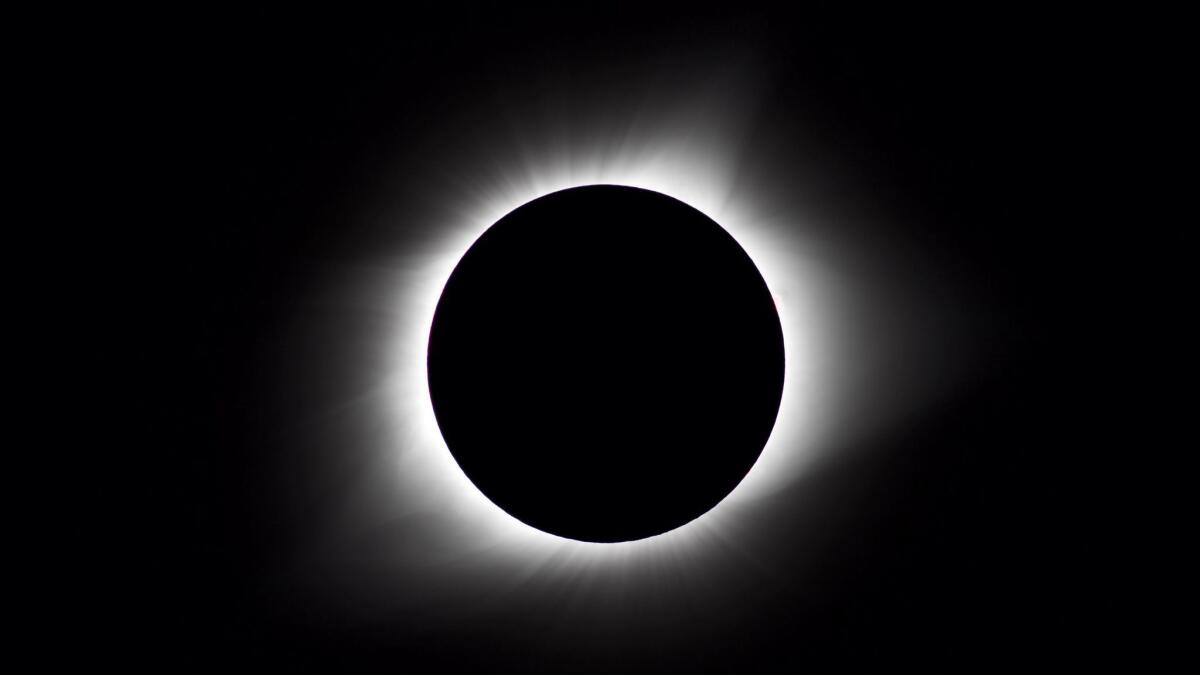
Tens of millions of Americans witnessed the Great American Eclipse on Monday, and for most of them it was a once-in-a-lifetime experience. But for Pasachoff, standing in the shadow of the moon is part of the job.
Over nearly 50 years of studying the physics of the sun, Pasachoff has become the world’s premier expert on total eclipses. As of Monday, he has witnessed 34 of them.
During the 1 minute and 56 seconds of totality in Salem, he and his collaborators ran more than a dozen experiments that will help them study the dynamics of the solar atmosphere, determine its temperature and pressure, better understand its magnetic field and learn how our planet responds when the lights abruptly go out in the daytime.
The sun’s outer atmosphere, known as the corona, is only visible during a total eclipse, so Pasachoff has made it his life’s work to show up at every single one he can get to — no matter where in the world it is.
“I think we can safely say Jay has seen more total eclipses than anyone alive today,” said Mike Kentriankis, project manager for the American Astronomical Society’s solar eclipse task force. “That means he’s seen more than anyone in the history of the planet.”
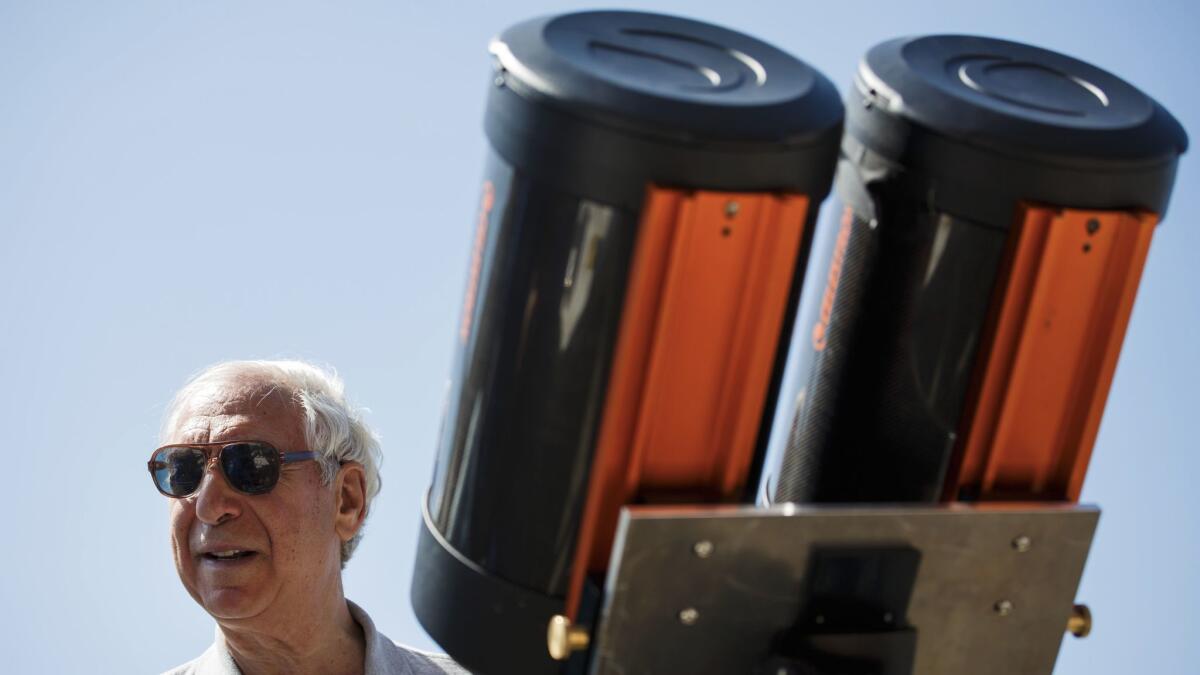
You always remember your first
Pasachoff was just 16 when he saw his first total eclipse. It was 1959, his freshman year at Harvard University.
He was enrolled in a seminar with Donald Menzel, an acclaimed astrophysicist who had been chasing eclipses since he was a kid in Colorado back in 1918.
Menzel led 16 eclipse expeditions during his career, including to the Russian steppe in 1936, the Canadian province of Saskatchewan in 1945 and northern Italy in 1951.
For the 1959 eclipse, which conveniently began over the Massachusetts coast, he borrowed a plane to fly his students above the clouds so they could see the glory of the sun’s outer atmosphere.
“As the full Moon covered the Sun and the sky darkened to black, the Sun’s corona outlined the Moon in white,” Pasachoff wrote in his log at the time. “I was hooked.”
He saw his second total eclipse nearly four years later, driving with a friend to the banks of the St. Lawrence River in Canada to witness the show.
In graduate school, Pasachoff studied solar physics, using an observatory in Sunspot, N.M., to observe a thin layer of the sun’s atmosphere known as the chromosphere. This area lies between the corona and the main face of the sun, and it is possible to see it even without an eclipse.
Pasachoff missed a total eclipse in Peru in 1966 and one in Russia in 1968. However, in March of 1970, he reunited with his mentor Menzel to take scientific measurements of a total eclipse over Oaxaca, Mexico.
“I learned a lot that year from him about solar physics and how to run an expedition,” he said. “All of this is passed-down knowledge.”
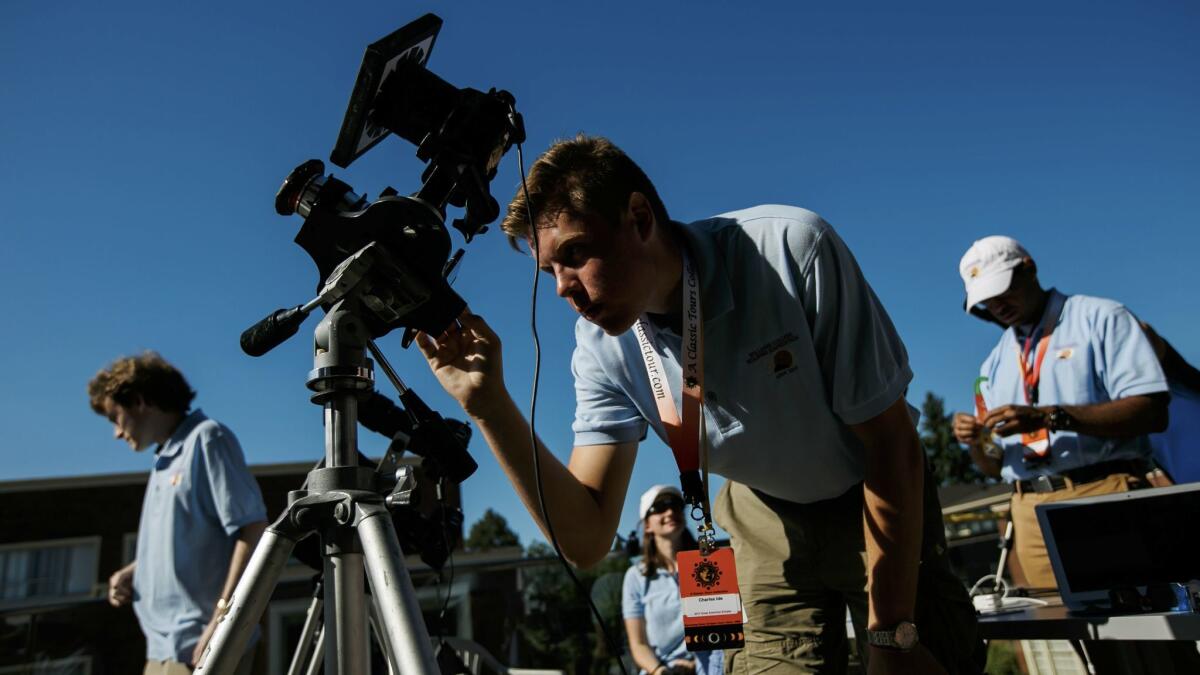
Years of preparation
Now Pasachoff, 74, is the one in charge. He usually begins preparing for an eclipse at least three years in advance.
The primary consideration, always, is weather. Much of his research depends on being able to see and measure the wispy structure of the corona. A single cloud in the wrong spot at the wrong time can doom an expensive, time-consuming expedition. Places with an early-morning marine layer or predictable late-afternoon storms are avoided at all costs.
The Great American Eclipse cast its shadow across the U.S. from Oregon to the Carolinas, so there were plenty of locations to choose from. Pasachoff began the selection process by studying color-coded maps and graphs that chart cloud patterns going back a couple of decades, helping him increase the odds of finding clear skies.
Logistics are also a consideration. Dozens of students and collaborators typically accompany him on his trips, and they bring with them an impressive number of telescopes, cameras and data-gathering weather stations.
Pasachoff determined that central and eastern Oregon had the highest chance of having clear skies on the big day. When he realized the town of Salem was home to Willamette University — and that the school’s president was an astronomer he knew — he was sold.
That was three years ago.
Finding the location was just the beginning. It takes a tremendous amount of work to get ready for the precious few minutes when the moon covers the sun.
Pasachoff applied for multiple grants, helped collaborators find lodging, and wrote dozens of letters of recommendation so that colleagues from Venezuela, China, Greece and other countries could get visas to join him in Oregon.
He also supervised a team of eight college students who spent the summer making sure more than a dozen telescopes and cameras were in good working order so they could capture the corona at the moment of totality. Then a colleague drove the two tons of observing equipment 3,400 miles across the country.
“I remember years ago, some people asked me if I would give a course on expeditions,” Pasachoff said. “I said, ‘My real expertise is packing and shipping.’ ”
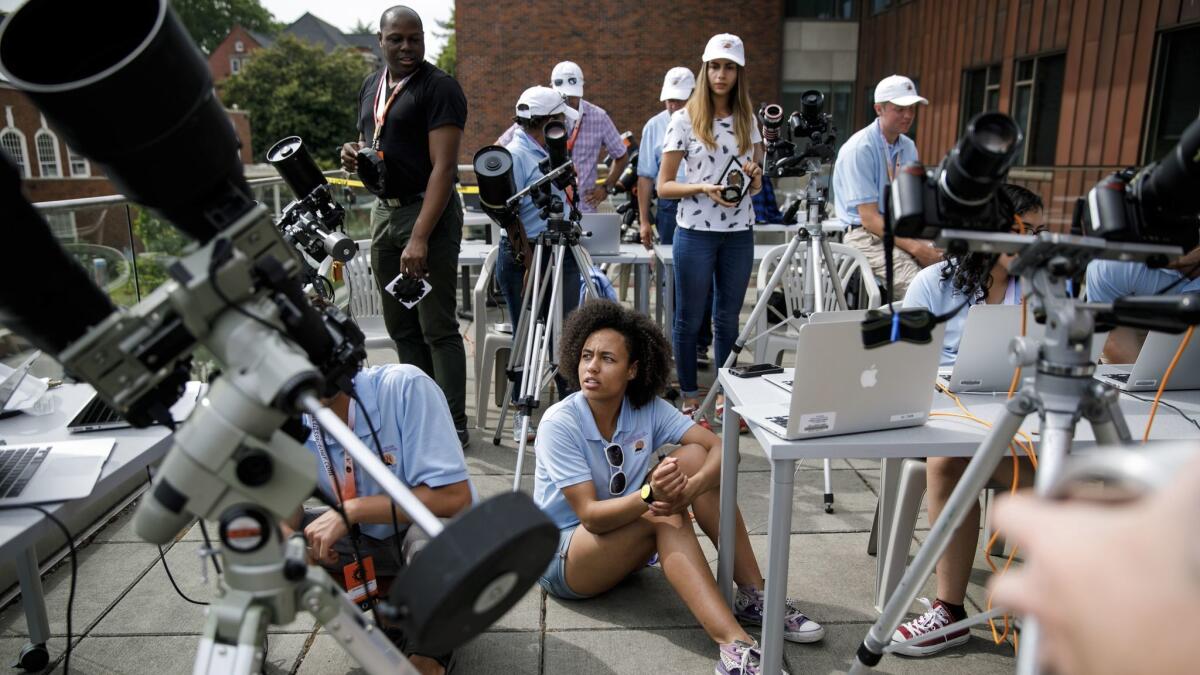
A dress rehearsal
Pasachoff and his students arrived in Salem about a week before the eclipse to set up their instruments and make sure nothing was damaged in transit.
The most sophisticated setup included two identical telescopes outfitted with different filters, which allow scientists to observe different temperatures of iron gas in the corona.
“We’re hoping to see high-frequency oscillations between these two spectra that can only be seen during an eclipse,” said Michael Person, a research astronomer from MIT. The results could help scientists improve their models of the sun.
On the day before the eclipse, Pasachoff conducted a dress rehearsal involving about 20 current and former students.
Half of them took their places in front of computers, running the programs that would guide the cameras as they tracked the sun during totality, the time when the moon completely covered the sun.
The others were tasked with quickly removing protective solar filters from the instruments as soon as totality occurred and the corona became visible. (Since the corona is only about as bright as a full moon, it’s safe for both people and cameras to look at it directly.)
The job of filter remover is more delicate than it sounds: A forceful step too close to an instrument could throw its delicate calibrations off balance.
“Totality!” Pasachoff yelled.
The silence of the quiet campus was broken by the sounds of many shutters clicking.
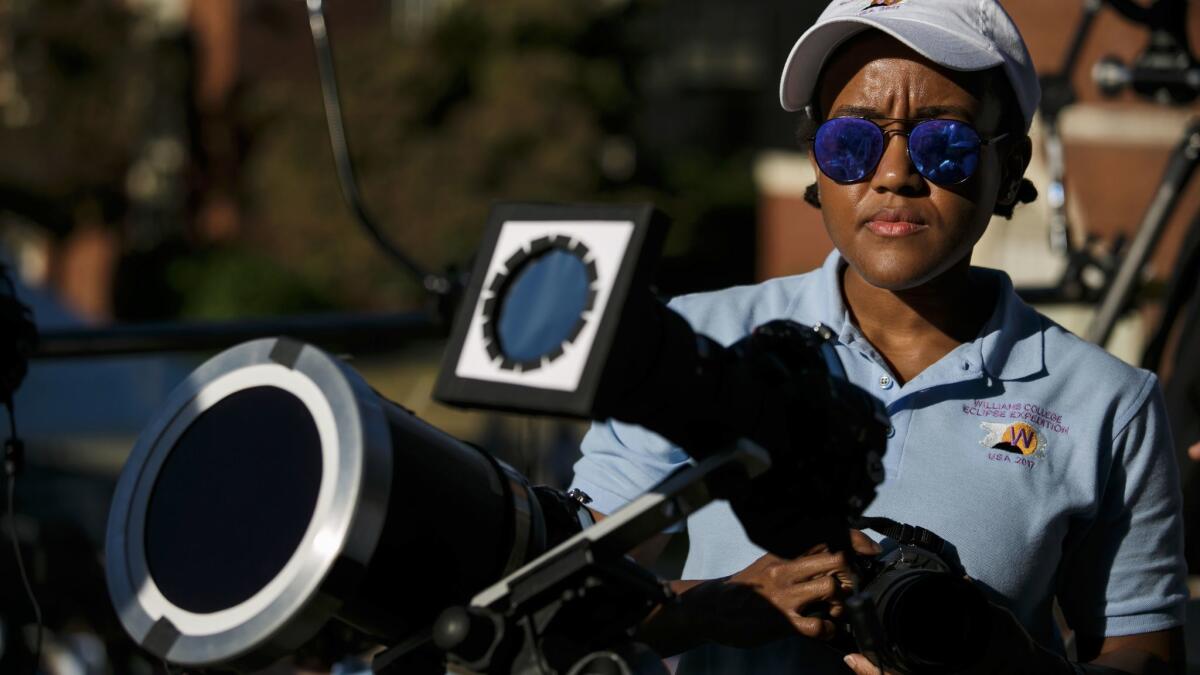
The next one
Things went just as smoothly on Monday, despite the large crowds that had gathered on campus to witness the real thing.
You might think that after years of preparation, the science team would feel a little let down once the 116 seconds of totality had passed. Instead, they were vibrating with excitement.
It took Amy Steele about 20 minutes to stop crying after the moment of totality passed.
"It was so pretty — it was just so pretty," said Steele, an astronomy graduate student from the University of Maryland. “The moon was so black, like a hole in the sky. And Mercury! We never get photons from Mercury. It was so good.”
Pasachoff was less emotional, but no less enthusiastic.
“It was fabulous!” he said. “It went as perfectly as possible. We’re looking at the first images and it was beautifully captured.”
He’s already preparing for eclipse No. 35. It takes place in Chile on July 2, 2019.
“Half a dozen years ago I contacted the head of an observatory right in the path of totality,” Pasachoff said. “He said, ‘Jay, I’ve been expecting to hear from you.’ ”
Do you love science? I do! Follow me @DeborahNetburn and "like" Los Angeles Times Science & Health on Facebook.
MORE ON THE GREAT AMERICAN ECLIPSE
Miss the eclipse? Another one is coming in 2024
From Oregon to South Carolina, the solar eclipse delivered a shadow of awe across the land
Great American Eclipse: Everything you need to know
These eclipse addicts go to great lengths, again and again, to stand in awe of the heavens




